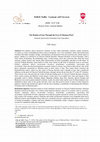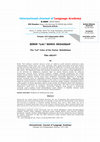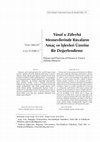Dissertation by Ülkü Akçay
THESIS by Ülkü Akçay
Papers by Ülkü Akçay

Akademik Dil ve Edebiyat Dergisi, 2023
The lover, the beloved and the rival are the most frequently encountered characters in classical ... more The lover, the beloved and the rival are the most frequently encountered characters in classical Turkish literature. Divan poets, as the voice of the lover, constructed rich imaginaries through these three figures, often reproaching the lover through their verses and refraining from complimentary language. These poets would make use of various similes in order to demonstrate the intensity and uniqueness of the love of the lover, who was subjected to a variety of torments, for the beloved. One of the techniques utilized by poets who would become one with the lover in their poems was to liken their state to famous lovers or to compare their love with theirs. The protagonists of the double-hero love tales of Arabic and Persian literature such as Layla and Majnun, Yusuf and Zulaikha, Khosrow and Shirin/Farhad and Shirin, and Vamiq and ‘Adhra are among the most common figures for such comparisons. They sought to display the depth of their own love through well-known representatives of the concept of love such as Farhad, who pierced Mount Bisutun for his love, Majnun, who wandered through deserts for the sake of his passion and became a companion to wild animals, and Vamiq, who struggled to come together with ‘Adhra, and thus show how far he themselves ventured on the path of love. Fuzuli and Hafez frequently mentioned the heroes of the famous love masnavis, Farhad, Majnun and Vamiq, in their ghazals.

Turkish Studies, 2023
For centuries, places referred to variously as cities, lands, homelands, countries, realms, terri... more For centuries, places referred to variously as cities, lands, homelands, countries, realms, territories or regions, as well as geographical features such as mountains, seas, rivers and plains, along with architectural structures like baths, mosques, bridges, and fountains, all toponyms in the most general sense, found a place in poetry, whether it is referred to as Classical Turkish literature, Ottoman literature or Divan literature, with a wide variety of functions. By mentioning such c in their poems, poets also conveyed clues about the social structure, culture, history and various other characteristics of those geographies and places to the future. In classical Turkish literature, many kinds of works were written on the basis of toponyms such as şehrengiz, biladiye, sahilnâme, sûkiyye, mesairnâme, miyahiyye, dergehnâme, seyahatnâme, sefaretnâme and menzilnâme. Poets also discussed toponyms in poems written in various verse forms in their divans. One of the places frequently mentioned by Ottoman poets in their works is Iran. This article firstly examines the Iranian/Persian region, which was the center of Persian literature and is thought to have had a significant influence on the poets of Classical Turkish literature, through various divans from the 14 th to the 19 th centuries. Those divans were selected from the works of both the leading poets of classical Turkish literature and poets from various regions and different social statuses. It then goes on to explore how cities and regions in that geography such as Tabriz,

International Journal of Language Academy, 2022
During the era called classical Turkish literature, the use of toponyms with various functions in... more During the era called classical Turkish literature, the use of toponyms with various functions in poetry has been encountered frequently. It is possible to state that the determination of the contexts and functions of toponyms in classical Turkish literature texts, and in other words, the use of toponyms in Ottoman poetry gave clues to the Ottoman cultural history. Many valuable studies have been carried out in this area are to reveal the importance of determining the unity of poetry and the city by evaluating the use of places in poetry. Today, the Badakhshan region spreads over a wide geography within the borders of Afghanistan and Tajikistan. It is located among the Hindu Kush Mountains in the south, East Turkestan in the east, Kunduz River in the west. Badakhshan is a region where gold, ruby and other mines are extracted, and it is one of the hundreds of places that poets often mention in their works with various features. In this article, it is aimed to review how Badakhshan was addressed in poetry, to determine which dreams and metaphors were used as poetic material and thus to contribute to the explanation of how the place in poetry is represented by using the data obtained from ghazels as a result of a literature review including all centuries of classical Turkish literature.

Rüyanın, antik medeniyetlerden beri günlük hayat, kutsal metinler, edebiyat gibi farklı sahalarda... more Rüyanın, antik medeniyetlerden beri günlük hayat, kutsal metinler, edebiyat gibi farklı sahalarda çeşitli amaç ve işlevleri olmuştur. Rüya, genelde gayb bilgisine erişmede bir araç olarak görülüp ona belli bir kutsiyet atfedilegelmiştir. Yusuf peygam-berin peygamberliğinin rüyayla başlaması ve rüya tabir ilmiyle teçhiz edilmesinin, bu kutsiyeti pekiştirdiği düşünülebilir. Rüya motifinin özellikle Yusuf u Züleyha mesnevilerinde tahkiyede sıkça başvurulan, çeşitli amaç ve işlevleri olan bir öğe olduğu görülmektedir. Süle Fakih, Şeyyad Hamza, Darîr, Garîb, Hamdî, Hatâyî, Kemalpaşazade, Taşlıcalı Yahya ve Gubârî'nin bu çalışmada incelenen mesnevilerinde bu amaç ve işlevlerin gelecekten haber verme ve harekete geçirme, şimdiki zaman bilgisi verme, âşık etme, müşkülün halli/öğüt verme olduğu tespit edilmiştir. A B S T R A C T Dreams had various purpose and functions in different fields such as daily life, holy books and literature, starting from the ancient civilizations. They have been usually seen as media to reach to the knowledge of the unknown and hence a certain sacredness has been credited to dreams. Prophet Joseph's initiation to the prophecy through a dream and his being endowed with dream interpretation ability can be seen as the components that enhance dream's sacredness. Dream, as a motif, especially can be observed as a frequently used element with various purpose and functions in the narration of Yusuf u Züleyha masnavis. We have distinguished these purpose and functions as to give the knowledge of the future and to trigger the character for a certain action, to give the knowledge of the present, to make the character fall in love with someone, to overcome a difficult situation/to give advice to the character , in the masnavis of Süle Fakih, Şeyyad Hamza, Darîr, Garîb, Hamdî, Hatâyî, Kemalpaşazade, Taşlıcalı Yahya and Gubârî that we have gone through for this paper.
1857’de Diyarbakır’da doğan Ali Emîrî Efendi, Millet Kütüphanesi’nin kurucusu, şair, araştırmacı ... more 1857’de Diyarbakır’da doğan Ali Emîrî Efendi, Millet Kütüphanesi’nin kurucusu, şair, araştırmacı ve kitapseverdir. Emîrî’nin istinsahını yaptığı metinler hariç; toplamda 16 manzum ve mensur eseri vardır. Emîrî’nin eserlerinin 3 tanesi padişahların divanlarındaki şiirlere yaptığı tahmislerden oluşur. Bunların dışında II. Abdülhamid’e yazdığı şiirleri ihtiva eden Levâmi’ü’l-Hamîdiyye adını verdiği bir eseri daha vardır. Bu makale Ali Emîrî’nin Osmanlı padişahlarına duyduğu hayranlığı, O’nun padişahlara yazmış olduğu şiirleri üzerinden değerlendirmeyi amaçlamaktadır.
Anahtar Sözcükler: Ali Emîrî Efendi, II. Abdülhamid, padişah, Levâmi’ü’l-Hamîdiyye
CONFERENCE PRESENTATIONS by Ülkü Akçay
PROJECTS by Ülkü Akçay
BOOKS by Ülkü Akçay

Uploads
Dissertation by Ülkü Akçay
THESIS by Ülkü Akçay
Papers by Ülkü Akçay
Anahtar Sözcükler: Ali Emîrî Efendi, II. Abdülhamid, padişah, Levâmi’ü’l-Hamîdiyye
CONFERENCE PRESENTATIONS by Ülkü Akçay
PROJECTS by Ülkü Akçay
BOOKS by Ülkü Akçay
Anahtar Sözcükler: Ali Emîrî Efendi, II. Abdülhamid, padişah, Levâmi’ü’l-Hamîdiyye